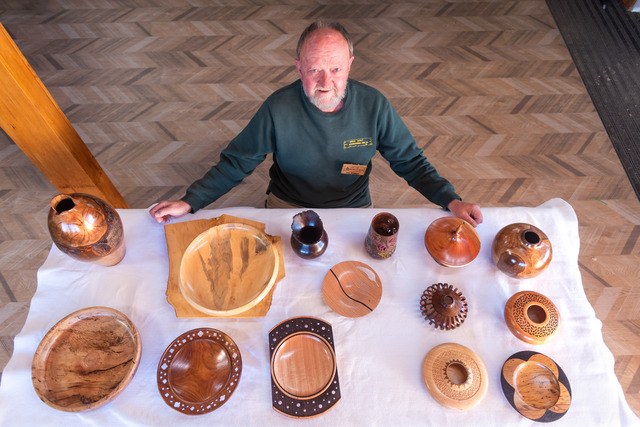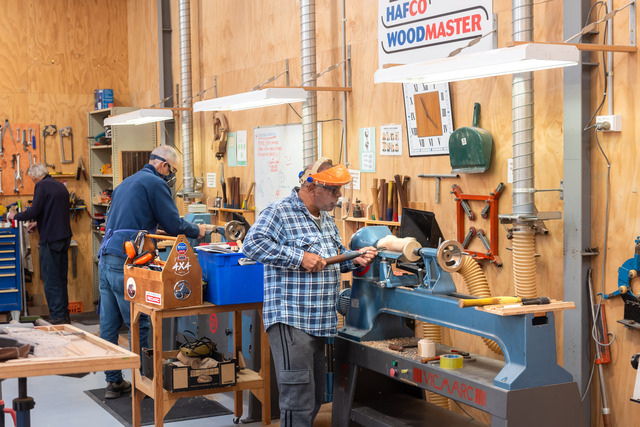By Violet Li
John McMahon has more than enough to offer when it comes to woodcrafts.
A visit to his workshop in the Berwick District Woodworkers Club would stun you with a variety of his crafts: a vase made from Japanese weeping cherries that he encountered in his friend’s front garden, a born-again decomposed rotten elm plate, a delicately shaped mess mate pot with kaleidoscopic butterfly hollows, and certainly, the wood gadgets for children.
The 2024 Lindsay King Art Award winner, John has been dealing with woods and contributing to the handmade toys the club makes for local children’s charities since he became a member in 1996.
A lot has changed over the years. Woodwork used to be tucked away somewhere in the club or their owners’ cabinets. Now, they are displayed at an annual exhibition in July as part of the Casey Winter Arts Festival, a new agenda that started about four years ago for people see the craftsman’s spirit.
But the stage is not big enough. Now, John has been brewing a bigger vision for the appreciation and conservation of his lifetime devotion: to establish Australia’s first National Woodcraft Collection and Exhibition Centre in Berwick.
“It’s a two-fold vision. We also want to develop a craft hub,” John said.
“We’re talking about all sorts of craftwork, like metalwork, glasswork, and pottery work. People, clubs, or individuals who are trying to set themselves up as professionals, and are still in the early days, can hire these rooms.
“And the general public will come in, and they’ll be able to see all the woodwork and all these people doing all these other craft works at the same place.
“This is all part of the vision, and we want to develop it as a major tourist attraction, but we also want to develop it as a community-based thing where people get encouraged to mix and become friendly and get that support and communal in.”
For the past three years, John has been promoting this vision amongst all the local, State, and Federal MPs and the council to make it move ahead.
“Some of the Australian timbers are renowned around the world for their quality and their character. And we’ve got woodworking practitioners that are world famous. And when they make something, it finishes up in galleries all around the world,” John said.
“But we don’t have anywhere in Australia that collects Australian woodwork as part of the National Estate.
“What happens is a museum or a gallery might get a piece of a table or a chair or a cabin, and they put that one piece of woodwork in a big room that’s got all paintings already. When people come in to see it, they see all the paintings but don’t pay any attention to that bit of woodwork.”
For woodwork collectors, the common fear is that when they die, all their woodwork will finish up at the local op shop, including pieces that are worth thousands of dollars, John observed.
“I’ve always felt that, done the right way, any bit of woodwork can be considered a piece of art,” he said.
Motivated by the perspectives, John has been trying to encourage people to consider that they’re producing art and get them to perceive it as art.
“Five years ago, a lot of our club members would come here, and they’d just make the toys, and they’d make themselves a box to put stuff in for home,” he said.
“But now when they come here and they do their box, they take a bit more pride in it, a bit of care in it, and they think about more what the finished product is going to look like, and they put more work into it, making it into a piece of art.
“And the community is starting to see that [as art] as well.”
John’s approach to woodcraft has been philosophical in nature. A process appearing laborsome to an outsider gives him “a chance to be creative” and “an escape in his mind from other things”.
His favourite part is oiling. The oil soaks into the wood and coats shininess around it. It depends on the wood on how many coats of oil need to be used. The more coats of oil you put on, the shinier it will get.
“You usually start with anywhere from two to three coats of oil. But then depending on the wood, you might finish up putting 10 or 12 coats of oil on,” he said.
“You leave it for about 10 minutes for it to soak in, and then you rub it all off. All the excess oil gets rubbed off.
“When the oil soaks in, it soaks in more in some places than in other places. Then you have to wait for anywhere from 12 to 24 hours to do another coat.
“You do your second coat; you just keep repeating that until it’s no longer soaking oil anywhere.
“If you’re doing 12 coats, it’s 12 days just doing the oiling. But you’re only spending 10 minutes a day doing it.”









